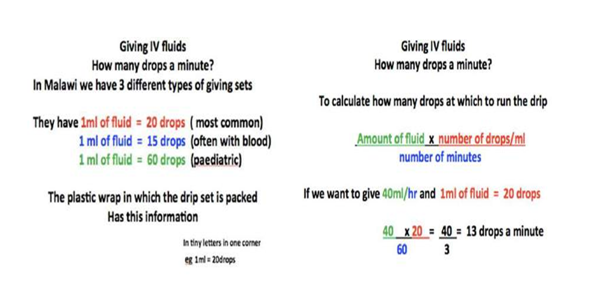
Exclusive breastfeeding is recommended in the majority of cases as it provides the best nutrition and protection from disease whilst promoting growth and development. Term infants that are well should be breast fed on demand. If this is not possible e.g. mum or infant is sick, then expressed breast milk should be given. Maintenance fluid is the amount of fluid required to replace losses and is calculated on the age and weight of the infant. During the first few days of life, feeds are given in smaller amount and gradually increased.
THE CALCULATION OF MAINTENANCE FLUIDS FOR NYI
| Day of life | How to calculate maintenance fluid requirements (1) |
|---|---|
| Day 1 | 60 ml/kg per day |
| Day 2 | 90 ml/kg per day |
| Day 3 | 120 ml/kg per day |
| Day 4 | 150 ml/kg per day |
| Day 7 and LBW | When the infant tolerates oral feeds well, the amount of fluid might be increased to 180 ml/kg per day after some days. |
Feeds are given every two or every three hours by naso/oro-gastric tube or cup feeding depending upon the maturity of the baby. Premature infants <34 weeks may not be able to breast feed and will require tube or cup feeds.
Premature infants should be fed smaller volumes, more frequently as their stomach volume is small, ideally every two hours or occasionally every hour.See Maintenance oral fluids chart for the volume of feeds to give NYI depending on their age, maturity and the splanned frequency of their feeding.
If there is a contraindication to oral feeding (including naso, oro-gastric tube and cup feeding) give IV fluids. Contra-indications to oral feeds may be medical or surgical.
Possible reasons for not feeding by mouth or gastric tube
Medical
Surgical
The choice of fluid depends on the age of the NYI. 10% dextrose is used for the first two days of life, because the baby’s kidney is immature. (If 10% dextrose not available, use Ringers Lactate or Normal Saline). On the third day if not already on Ringers Lactate or Normal Saline, change to it and add glucose to make it up to 10% dextrose (1).
What volume?Maintenance fluid is the amount of fluid required to replace losses and is calculated on the age and weight of the infant. However IV fluids can quickly overhydrate a NYI.
Generally, we do not exceed 100 ml/kg per day when administering maintenance fluids by the IV route to NYI.See wall charts for the volume of fluids per hour based on the child’s weight and age.
 |
|---|
Weight and urine output are the best overall clinical guides to assessing the adequacy of therapy. Introduce milk feeding by oro-gastric tube or breastfeeding as soon as it is safe to do so. Oral feeds are slowly increased while IVs are gradually withdrawn, the oral intake must be taken into account when calculating the IV rates. Reduce the IV fluid rates as the volume of milk feeds increases in infants on oro-gastric feeds. Discontinue IV fluids once oral intake reaches 2/3rd total.
If stable and feeds are not contraindicated
If there is a contraindication to oral fluids/feeds